Shrouded by myth, from the alleged feisty temperament to connections with vampires and lottery winnings, red hair rarely goes unnoticed. It can accompany differences in pain tolerance, temperature change sensitivity, easy bruising and increased likeliness for left-handedness, and has even been rumored to be headed for extinction because of its rarity. However, it appears as though it’s here to stay and continue to maintain its coveted status.
Hair Genetics
Tucked away on chromosome 16 lies a gene that influences your hair, skin and eye color. The Melanocortin 1 receptor gene, or MC1R, controls cells called melanocytes, which make pigment called melanin. There are two types of melanin: eumelanin, which is a dark shade of brown, and pheomelanin, which is reddish. The MC1R gene influences how much of each pigment is produced, which in turn determines what your hair color will be.
You inherit two copies of your genes, one from each parent, and they sometimes contain conflicting instructions. European Monk Gregor Mendel (1822-1884) conducted research using pea plants and was able to determine that some genes are dominant (they overpower the other gene they are paired with) and some are recessive (they can be hidden). Dark hair is dominant, and red hair is recessive. Blue eyes are also recessive. As a result, blue-eyed redheads are the rarest combination in the world, comprising only about 1 percent of the population.
Skin Type and Eye Color
While blue eyes sometimes beat the genetic dice toss and end up paired with red hair, those with carrot locks usually have brown or hazel eyes. Redheads have fewer hairs on their heads, reaching around 90,000 strands compared to 110,000 for blonds and 140,000 for darker shades. Paler, freckled skin and less protective hair makes gingers more susceptible to sunburn and skin cancer. The upside to this lighter skin is that redheads have an easier time manufacturing vitamin D with less sun exposure. It’s no wonder that cloudy Europe boasts the highest concentration of redheads in the world, reaching as many as 13 percent in Scotland, compared to a paltry 2 percent in the United States.
Skipping Generations
If two parents have dark hair, who could cause their child to have hair that is red? Grandparents who passed down the recessive MC1R gene, that’s who. Brown hair is dominant, so each dark-haired parent could have one dominant brown and one recessive red gene. All it takes is for the two recessive reds to match up in the offspring, and voila, next generation ginger.
Anyone can get red hair with a visit to the hair care aisle at a pharmacy, but those who have an MC1R gene that triggers predominantly pheomelanin production can skip the dye and still enjoy this dynamic, eye-catching color.
Hair Loss Help
New Look Institute specializes in hair replacement and hair restoration solutions for everyone and for every hair loss condition. We invite you or anyone you may know who is experiencing hair loss to a free visit with one of our hair loss specialists. Contact us today!
Photo Credit: Brooke Duckart via Flickr Creative Commons
Sources:
http://www.huffingtonpost.co.uk/emmakelly/redhead-facts_b_4781153.html
http://gingerparrot.co.uk/facts-and-myths-about-red-hair/
http://www.livescience.com/39095-redhead-health-risks.html
http://genetics.thetech.org/ask/ask144
http://ghr.nlm.nih.gov/gene/MC1R
https://udel.edu/~mcdonald/mythredhair.html
http://genetics.thetech.org/ask/ask245
http://anthro.palomar.edu/mendel/mendel_1.htm
http://www.dailymail.co.uk/news/article-2401346/Ginger-genes-Research-reveals-20MILLION-red-hair-gene-carriers-Britain-Ireland.html
http://www.schwarzkopf.international/sk/en/home/hair_repair/tips_and_tricks/hair_science/amazing_titbits_on_hair.html#id230236374http://www.schwarzkopf.international/sk/en/home/hair_repair/tips_and_tricks/hair_science/amazing_titbits_on_hair.html#id230236374







